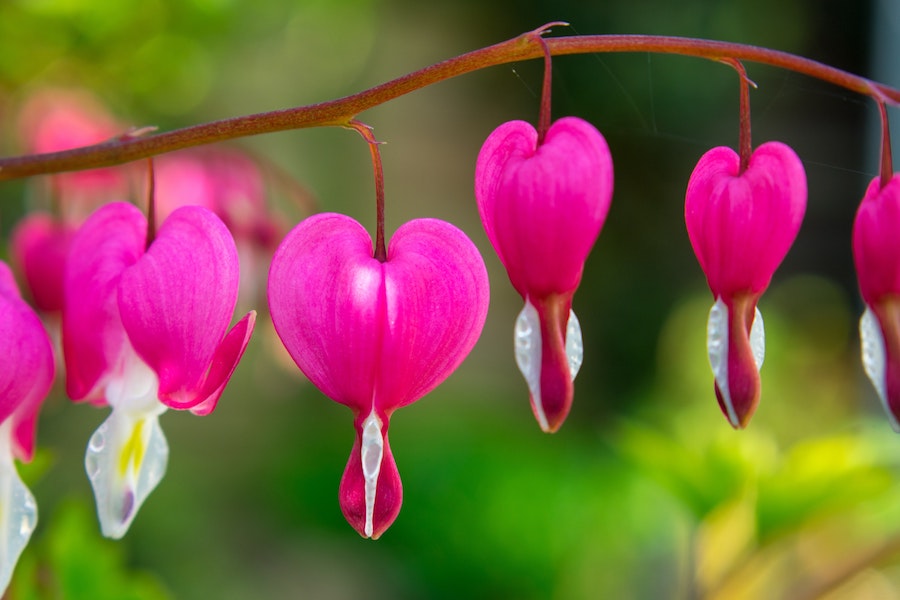5 of the most romantic plants for Valentine’s Day
Let love bloom with these heartfelt choices
Bunch of red roses not going to cut it with your green-fingered Valentine this year?
There are other romantic plants you could opt for, which also represent love, passion and devotion and should – hopefully – grow and blossom with time!
Medieval myths and folklore, heart-shaped flower forms and even the love-inspired name of a plant can all stir the most romantic notions – and there there are certain plants that naturally fit the bill.
Here are five Valentine’s Day plants perfect for saying ‘I love you’…
1. Bleeding heart (Dicentra spectabilis)

The flowers of Dicentra spectabilis say it all
It’s the delicate heart-shaped flowers in shades of pink and white, or solid white on arching stems on this beautiful spring-flowering perennial which make this plant one which stands out from the crowd. Easy to grow, it does best in moist soil with added organic matter in partial shade in a sheltered spot.
Taller dicentras, which grow to around 80cm, make good plant partners with low-growing plants including hellebores, saxifrages and hardy geraniums.
2. Lilac (Syringa)

Purple lilac symbolises love
In the language of flowers, purple lilacs symbolise the first emotions of love, while white lilacs represent youthful innocence. In the garden, their heady scent and beautiful blooms bring more romance to the scene in early summer and there are many varieties in different hues of pink, purple and white.
The hardy lilac, Syringa vulgaris, grows on most soils including clay, but prepare the ground well with plenty of well-rotted compost to encourage a good display of flowers, preferably in a sunny location. Watch out for suckers, which can start to take over if you don’t pull them out immediately.
3. Myrtle (Myrtus)

Myrtle plant
A sprig of this evergreen shrub has been featured in many royal bridal bouquets since 1858, including those of the Duchess of Cambridge and the Duchess of Sussex, as the plant represents good luck and love in a marriage.
This Mediterranean shrub grows to 3x3m, with oval, polished, leathery aromatic leaves that release a spicy orange fragrance when crushed. The fragrant flower buds open to white flowers in July to August, followed by fleshy berries which mature to purple-black.
Being from the Mediterranean, it’s best grown against a sunny wall in a sheltered spot and looks good in cottage or coastal gardens. It can also be grown in a large pot in sunny city gardens. It does, however, require long hot summers to produce flowers and fruits.
4. Forget-me-not (Myosotis scorpioides)

Forget-me-nots create a blue haze
There are many myths surrounding the origins of the name ‘forget-me-not’, but these plants grown as biennials are largely associated with remembrance and love.
French medieval legend has it that a knight was trying to pick the flower for his lady, but fell into the river in heavy armour and, before sinking, tossed the flower to his love and shouted, ‘Forget me not!’
Forget-me-nots are useful to add colour to spring bedding displays, creating a haze of blue, pink or white blooms with yellow centres which are a magnet for bees and butterflies. Pair them with tulips, late daffodils and ranunculus for best effect. They prefer moist soil in partial shade and are perfect for underplanting beneath summer-flowering deciduous shrubs.
5. Rose

Roses may need a little looking after, but they bring romance into the garden
Of course, this is the most obvious choice. According to Greek mythology, roses are associated with Aphrodite, the goddess of love and beauty.
There are so many from which to choose – literally a rose for every garden, from miniature versions in a pot, to a large old-fashioned fragrant English rose, with hand-sized blooms emitting a perfume which will fill the air.
They are hungry plants and are happy in heavier soil in a sunny spot. Add plenty of organic matter to the soil before planting and dig a big enough hole so the roots have space to spread out.
The Press Association
Latest posts by The Press Association (see all)
- What you need to know about weight loss jabs and how to make them work effectively - April 25, 2025
- Is our skin more susceptible to sun damage as we age? - April 25, 2025
- Special stamps to mark 80th anniversary of VE Day - April 24, 2025
- Test your knowledge with our penguin-themed quiz - April 24, 2025
- Prince Louis shows off missing front teeth in new photo to mark seventh birthday - April 23, 2025



















